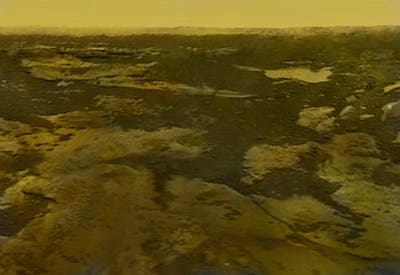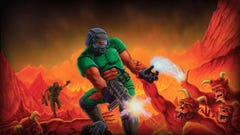After 23 years, Starfield's ancestor Noctis is still a vision of the future
Drift apart.
Over the decades I've been playing video games, I've flown spaceships made of futuristic alloys and bubbles of energy, and I've flown spaceships hammered together from wooden planks, chunky metal bolts and flapping sailcloth. I've flown ships that extrapolate believably from the design of the International Space Station, and I've flown ships that are basically steam trains with an attitude problem. But not till Noctis, somehow, have I flown a spaceship made of glass. In this "dreamable space simulator" from Italian developer Alessandro Ghignola, released in 2000, you explore a galaxy's worth of solar systems in a Stardrifter - a chunk of polarised quartz that harbours a single, square room, more of a conservatory than a cockpit, with Centerparcs-style viewing domes protruding above and below.
Noctis players often affectionately refer to the Stardrifter as a "catbox", because the game's Feltyrion voyagers are said to be descended from cats. But any feeling of absurdity evaporates when you hit the Depolarise button. This switches off the electrical current running through the hull, turning those glass walls transparent and so, transforming your ship into a prism - a folded extravaganza of photons and facets, which derives its colour from the nearest star: gold, blue, green. The game's crunchy 320x200 display resolution only adds to the lustre of the refraction effects. It makes them feel artful and tactile in a way I don't think I've experienced in any space sim developed for more "powerful" hardware.
.png?width=690&quality=75&format=jpg&auto=webp)
.png?width=690&quality=75&format=jpg&auto=webp)
This, truly, is a ship for sightseeing, a lens drifting through the stars, and an appropriate vehicle for a game loop of visiting planets and uploading names and short descriptions to a community database - accessible within the game, and still tantalisingly incomplete, 23 years later. And what's this? The Stardrifter is also a screen. The text commands for scanning celestial bodies and engaging the ship's autopilot are displayed on the forward viewing window, their boxy white Casio fonts hanging among the constellations.
This interface proves very unwieldy, though there are a few keyboard shortcuts to ease the pain. You select options by holding right-mouse to root your character, then looking at the text and double-clicking, and the window is too wide to read in its entirety without reducing the options to a pixelated scrawl. So you must start at one end, move, right-click, and move again.
It's such a beautiful concept that I quickly forgave the fiddly execution, however, and in any case, that fiddliness lends itself to the idea that this is a game about playing with vision itself, dwelling on how light mutates depending on the medium, rather than simply seeing. You zoom and pan across the fonts and encounter different degrees of legibility or perplexity, depending on the solar conditions. Over time, this becomes the basis for using your craft in a more deliberate - dare I say, "mindful" - way, embracing the delays and ambiguities it imposes, rather than straining to optimise the process. If you find the Stardrifter's internal splendour overwhelming, you can always take the ship's central elevator to the upper hull and enjoy a relatively clear view in your spacesuit. But even your spacesuit fits into that gentle, wider theme of faffing around with the mechanics of sight: it has a radiation visor that works like a post-processing filter, sharpening or blurring the stars as you please.
All this, and I'm still getting to the business of landing on planets. Once you've aimed the Stardrifter's autopilot at a world, the forward window display gives you a bit of intel about its surface: creased or cratered, liquid or frozen, atmosphere or no atmosphere. Having moved into orbit, you select a landing site from a pixel map on the wall to the right, and are automatically transported to solid ground. In a lovely show of economy, your landing vessel actually consists of your Stardrifter's viewing domes, which clip together magically around you.
Each descent is akin to moving your head towards a densely painted canvas to discover the brushwork - a slow transition from the skybox towards a colourful, moody obscurity. You take note of any landmarks on the horizon, picking out something to investigate. The ground looms up and acquires objects and textures: scattered mineral slabs, scraped earth, pools of bright liquid and stabs of vegetation that nowadays call to mind the procgen islands of Proteus. Sometimes thick cloud cover plunges you into total darkness, and sometimes you're treated to mountains and valleys chopped and chiselled by a sun that resembles a huge mural on a temple wall. Having touched the earth, you slide through the lander's glass walls and head towards one of the terrain features you've identified, glancing back now and then towards the light beam rising from your landing site.
Often, you'll linger only to grab a few screenshots and settle on a name. The majority of Noctis planetary maps are devoid of structure. Many are tricky to navigate thanks to a shortage of landmarks - marooning yourself is a real possibility when the sky is so bright that you can't make out your lander beam - and only a handful support visible lifeforms, such as twitching emerald butterflies. These inhabited worlds are mesmerising, but I found myself more attracted to the less gratifying, barren planets, which make me think of space photography during the later 20th century, before glossy, high-resolution pictures of other worlds became everyday commerce on social media. I spent a long time on one particular, angry yellow planet that made me think of a Venera 10 photograph of Venus fmro the 1980s, which I first encountered in a school textbook - a menacing swathe of sulphur and compacted rock, transmitted in the few moments before the atmosphere reduced the lander to scrap.

Time has been similarly unkind to Noctis. I don't mean in terms of the ponderous handling or that unadorned loop of visiting and annotating solar systems - a simplicity of approach that makes me think of No Man's Sky at launch, before that game managed to colonise its own weirdness. I mean in terms of compatibility. Ghignola has released several versions of the MS-DOS original for free, one of which runs on Windows 10, but my Thinkpad struggled with all of them. Using an emulator to fire up the DOS version involves faffing around with CPU cycles to ensure a workable frame rate. The Windows 10-compatible version, meanwhile, crashes whenever I spend too long on a planet's surface.
I suspect these are perfectly fixable issues, however, and Noctis is worth the trouble, especially in the run-up to Starfield. Writing about his failure to accomplish certain development objectives for Noctis, Ghignola has described himself as "an honest kind of unwillful liar". I think that the Stardrifter is another "honest kind of liar". It shows you the galaxy, but it's also endlessly modified by the galaxy, taking its hue from its surroundings. Where spaceships in today's open world space sims are opaque and combative instruments, designed to keep the cosmos out in order to invade and conquer it, the Stardrifter lets the light in and opens itself to change.








